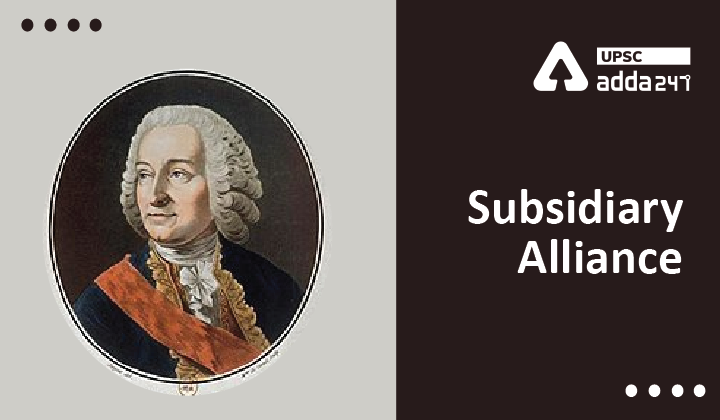Table of Contents
Subsidiary Alliance System- Relevance for UPSC Exam
- GS Paper 1: Indian History- Modern Indian history from about the middle of the eighteenth century until the present- significant events, personalities, issues.
What is Subsidiary Alliance System
- The subsidiary Alliance System was basically a treaty between the British East India Company and the Indian rulers.
- Under Subsidiary Alliance System, the Indian Ruler was made subservient to the wishes of the British East India Company (EIC).
- Hence, the Indian kingdoms who signed the Subsidiary Alliance lost their sovereignty to the English.
Background of Subsidiary Alliance System
- A French Invention: Subsidiary Alliance in India is considered to be a French alliance. French Governor Dupleix is credited with the introduction of the Subsidiary Alliance System in India.
- Dupleix was the first who lend European troops to the Indian state in return for some territory and influence over the native state.
- Lord Wellesley and Subsidiary Alliance: Lord Wellesley was an expansionist and wanted to reduce states to a position of dependence on the British Government in India.
- For this purpose, he introduced the system of subsidiary alliance which is considered to be an extension of the Ring Fence Policy.
Features of Subsidiary Alliance System
- Stationing of British Troops and Resident: The allies of the Indian state’s ruler were compelled to accept the permanent garrison of the British Army within their territories.
- The Subsidiary ruler had to pay a subsidy for its maintenance too.
- A British Resident was also stationed in the Indian Court.
- Imposing Dependence: An Indian ruler entering into Subsidiary Alliance with the British had to dissolve his own armed forces, making him completely dependent on the Britishers for the safety and security of the state.
- The ally Indian State also had to pay for the British army’s maintenance.
- In return, the British would protect the Indian state against any foreign attack or internal revolt.
- Clause of Non-Interference: The British promised non-interference in internal affairs of the Indian state who signed the Subsidiary Alliance System.
- However, this provision under Subsidiary Alliance was rarely kept.
- Loss of Sovereignty: Under Subsidiary Alliance, the Indian state could not enter into any alliance with any other foreign power.
- Barred from Employing Foreigners: With an aim to curb French influence, Indian Rulers were barred employ any other foreign nationals other than Englishmen in his service.
- And, if he were employing any he had to terminate them from his service.
- The Indian state could also not enter into any political connection with another Indian state without British approval.
- Barred from Employing Foreigners: With an aim to curb French influence, Indian Rulers were barred employ any other foreign nationals other than Englishmen in his service.
An Indian Ruler who signed the subsidiary alliance lost all powers in respect of foreign affairs and the military. He virtually lost all his independence and became a British ‘protectorate’.





 TSPSC Group 1 Question Paper 2024, Downl...
TSPSC Group 1 Question Paper 2024, Downl...
 TSPSC Group 1 Answer key 2024 Out, Downl...
TSPSC Group 1 Answer key 2024 Out, Downl...
 UPSC Prelims 2024 Question Paper, Downlo...
UPSC Prelims 2024 Question Paper, Downlo...





